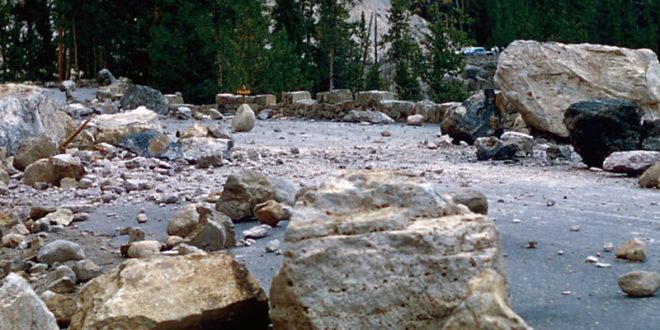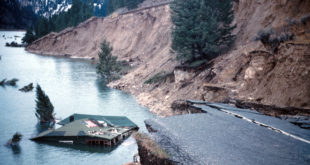The massive 7.2-magnitude Hebgen Lake earthquake on August 17, 1959 is still affecting the Yellowstone National Park region, according to a team of geophysicists at the University of Utah, who say a swarm of up to 3,000 events near Maple Creek from June 2017 to June 2018 is tied to that event.
That Hebgen Lake Earthquake was a momental moment in Yellowstone history, being the the strongest (and deadliest) in Montana history, resulting in the death of 28 people. Tons of dirt, rock and trees blocked the Madison River, leading to the creation of Quake Lake. And though the quake wasn’t centered in Yellowstone National Park, it certainly caused plenty of damage in the Park–the above National Park Service photo shows damage on the Yellowstone road near Gibbon Falls, and the quake famously toppled the dining-room fireplace in Old Faithful Inn–and altered the underground plumbing system used to power geysers, fumaroles and more.
And despite most of the damage occurring immediately after the earthquake, the effects of the Hebgen Lake earthquake are still being recorded today, according to the University of Utah researchers. Their research, published in the academic journal Geophysical Research Letters, suggests that the effects of the Hegben Lake Earthquake are ongoing, with the study focusing on the same direction and fault line and direction as the 1959 Hebgen Lake earthquake. The Maple Creek area has been well-documented as an ongoing area of seismic activity within Yellowstone National Park, with plenty of earthquake swarms recorded there over the decades, and University of Utah geoscientists Guanning Pang and Keith Koper studied the data in depth.
“These kinds of earthquakes in Yellowstone are very common,” says Koper, director of the University of Utah Seismograph Stations. “These swarms happen very frequently. This one was a little bit longer and had more events than normal.”
“We don’t think it will increase the risk of an eruption,” Pang adds.
According to a University of Utah press release:
The more than 3,000 small quakes of the Maple Creek swarm can be divided into two clusters. The northern cluster consists of Hebgen Lake aftershocks. The quakes fell along the same fault line, and were oriented the same way, as the Hebgen Lake event. Also, the team didn’t see signs that the northern cluster was caused by movement of magma and other fluids beneath the ground.
Koper and Pang says it’s not unheard of for aftershocks of a large earthquake to continue decades after the initial event. Pang, for example, has also studied aftershocks as recent as 2017 from the 1983 Borah Peak earthquake in central Idaho.
“There are formulas to predict how many aftershocks you should see,” Koper says. “For Hebgen Lake, there looked like a deficit in the number of aftershocks. Now that we’ve had these, it has evened things out back up to the original expectations.”
The southern cluster of the Maple Creek swarm seems to have a different origin. Although the northern cluster was lined up with the Hebgen Lake fault, the southern cluster’s lineup was rotated about 30 degrees and the quakes were about 0.6 miles (1 kilometer) shallower than the northern cluster.
So, the researchers concluded, although the shaking in the northern cluster influenced the southern cluster, the primarily cause of the southern shaking was likely subsurface movement of magma. “We do consider it to be one swarm all together,” Koper says. “Because they were so close, there was some feedback and influence between the two sections.”
Koper says that the results highlight how earthquakes are different than other natural hazards. Floods, hurricanes or wildfires are over when they’re over. “Earthquakes don’t happen as a single discrete event in time,” he says. The specter of aftershocks can continue for months, years or even, as Maple Creek shows, decades.
Yellowstone historian Lee H. Whittlesey explained in the forward to Larry Morris’ book on the 1959 earthquake:
Yellowstone receives hundreds of small earthquakes per year, and interpreters and geyser-gazers today still discuss the great changes that the ’59 quake imprinted onto the park’s geysers and hot springs. Historians and history buffs still examine with interest old photographs of rock slides, cracked roads and submerged houses, and Old Faithful Inn tour guides still orate about the earthquake damage to that famous building.
Amazing to think that a seismic event so long ago can still cause impacts today.
 Yellowstone Insider Your Complete Guide to America's First National Park
Yellowstone Insider Your Complete Guide to America's First National Park




